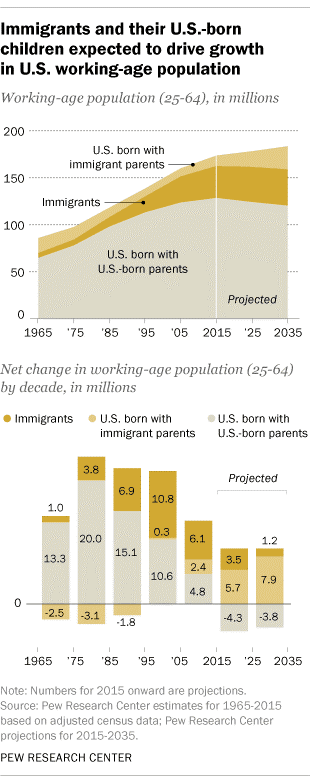


04/10/2017

The Baby Boomers are retiring! The Baby Boomers are retiring! And only immigration can prevent a decline in our working-age population — and, by implication, a decline in living standards! That was the message from a recent Pew Research Center report: Immigration projected to drive growth in U.S. working-age population through at least 2035, by Jeffrey S. Passel and D’Vera Cohn, March 8, 2017. It’s immigration-enthusiast bunk, of course, as proved by the counter-example of Japan.
Pew estimates that the retirement of Baby Boomers will reduce the number of U.S.-born people of working age (25 to 64) by 8.2 million, or 6.4%, over the 2015 to 2035 period. But Pew projects that 17.8 million new immigrants will enter over these two decades, enough to offset and exceed the aging and death of working-age immigrants already here by about 4.6 million.
Immigration over the next 20 years will increase the working age population by about 10 million above current levels, according to Pew. In contrast, if an immigration moratorium were implemented, the working age population would fall by about 7 million:
Note carefully: an immigration moratorium would mean a tighter labor market.
Conversely, projected immigration over the next 20 years will increase the working age population by about 17 million, or 10%, above the level that would have been reached under a moratorium. That means a looser labor market — and lower wages.
But Pew likely overstates immigration’s future role:
But quibbling about numbers distracts us from a more important question: Does the U.S. economy need any immigration at all?
A typical Immigration Enthusiast screed runs like this:
Relatively faster growth in the US population will translate into relatively faster economic growth… This is not optimism, but simple arithmetic. Japan and many European countries face long-term stagnation or even decline in their real GDPs — and hence the aggregate economic and fiscal resources available to pursue future-oriented agendas, from investing in the young to investing in national defense.Get it? More immigration means more workers, which means higher GDP — which means… we need more immigration![300 Million Americans: What Does It Mean? By Richard Jackson, Center for Strategic and International Studies, October 18, 2006]
Reality check: GDP does indeed rise when new immigrants enter the labor force, although essentially all of that is captured by the immigrants themselves in wages [Immigration and the American Worker: A Review of the Academic Literature, by George Borjas, Center for Immigration Studies, April 2013. Table 9, page 20.]
But living standards are best measured by per capita, not total, GDP. Per capita income falls if immigrants are less educated, productive, motivated than the native-born. And this is the case in the U.S., as seen in the Bureau of Labor Statistics’ latest annual survey of the immigrant workforce. Comparing median wage and salary income of immigrant and native-born workers in 2015, BLS found:
BLS, Foreign-born Workers: Labor Force Characteristics — 2015, May 19, 2016, Table 5.
Immigrant workers earned 81.4% of the native-born median income. Male immigrants earned only 76.2% of what native-born males earned in 2015.Recent arrivals (arriving within five-years of the survey year) are at an even greater disadvantage, earning only 65% of native-born median family income, according to a study released by Pew to mark the fiftieth anniversary of the 1965 immigration law [Modern Immigration Wave Brings 59 Million to the U.S., Driving Population Growth and Change Through 2065, By Jeffrey Passel and Molly Rohal, Pew Research Center, 2015. Figure 3.10].
Back in 1970, before the perverse selection of the 1965 Immigration Act had come into play, new arrivals received 88% of native-born American average incomes.
(These figures are adjusted for inflation and family size, giving a true picture of decline in the living standards of new entrants relative to the native-born).
And there’s a further point that immigration enthusiasts never make:
But additionally, from 1960 to 2011 Japan’s per capita GDP, measured in 2011 dollars of fixed purchasing power, rose 5.6 times, more than twice the 2.7 times increase recorded in the U.S.
Over this period, Japan followed a “Japan First” economic policy, discouraging the influx of people as well as foreign capital. Japan’s immigration policy is based on two principles: admission of highly skilled workers exclusively; and immigration only on a temporary basis.
The only exception to these rules: persons of Japanese descent. The government allows the recruitment of ethnic Japanese living abroad on long-term visas that include an unlimited work permit.
Foreigners today make up 1.4% of the Japanese labor force, tiny compared to the 16%-17% immigrant share of the U.S. workforce [Japan is looking for ways to bring in more foreign workers without calling it an 'immigration policy' by Linda Sieg and Ami Miyazaki, Reuters, April 26, 2016]
In recent years, Japan’s immigrant population has been practically unchanged, edging up from 1.55 million, or 1.22% of total population in 2005, to 1.98 million, or 1.55% in 2013.
Over the same period the U.S. immigrant population rose by more than 6 million, from 35.2 million (12.1% of total population) in 2005 to 41.3 million (13.1% of total population) in 2013.
The political dynamic affecting immigration policy is the same in both countries: Businesses want access to cheap labor; workers want protection. In Japan, for the most part, the government has sided with the people.
The result — painfully slow workforce growth — has forced Japanese employers to enhance the productivity of their racially homogeneous workforce with better technology, equipment, and training — producing the exceptional rise in GDP per capita.
And also producing, of course, a complete absence of Muslim terrorism.
Could Donald Trump’s “America’s First” replicate the success of Japan’s populist strategy? Yes.
Will it? Maybe. The jury is still out.
Edwin S. Rubenstein is President of ESR Research Economic Consultants.